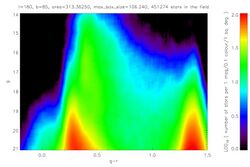Astronomy:Hess diagram
From HandWiki
Revision as of 16:15, 19 July 2022 by imported>Nautica (url)
Short description: Diagram of stars in astronomy

Hess diagram with data from SDSS b>80 degree
A Hess diagram plots the relative density of occurrence of stars at differing color–magnitude positions of the Hertzsprung–Russell diagram for a given galaxy or resolved stellar population. The diagram is named after R. Hess who originated it in 1924.[1] Its use dates back to at least 1948.[2]
Hess diagrams are widely used in the study of discrete resolved stellar systems in and around the Milky Way - specifically, in the analysis of globular clusters, satellite galaxies, and stellar streams.
See also
- Color-color diagram
References
- ↑ R. Hess (Heß) (1924). "Die Verteilungsfunktion der absoluten Helligkeiten in ihrer Abhängigkeit vom Spektrum". Probleme der Astronomie. Festschrift fur Hugo v. Seeliger. Springer, Berlin. p. 265.
- ↑ Gaposchkin, Cecilia Payne (1948). "The connection of motion with intrinsic variability.". Astronomical Journal 53: 193. doi:10.1086/106093. Bibcode: 1948AJ.....53..193G.
 |

